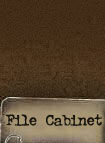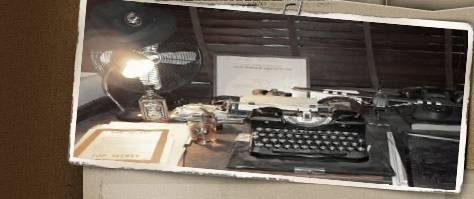
Item Description: Motion
Sickness Pills used on D-Day
Introduction:
Just prior to boarding the
C-47's Sky Trains that took the
paratroopers of the 101st to
their objectives in Normandy,
the medics, under orders from
the Regimental Surgeons, issued
air sickness pills to them.
These pills had a lot of
unwanted side effects.
The Story: Never during
paratrooper training in the
United States or prior to jumps
in England where these "Motion
Sickness Preventive" pills
issued to the paratroopers. The
D-Day jump, the 101st's Baptism
of Fire, would be the first
time. And the last time. The
pills had varying side effects a
soldier under fire can do
without.
These are accounts of said
effects that we have found in
the books:
1) "We were given 2 pills against
motion sickness, one around 22:00
and then another one while in the
aircraft. The idea being to do away
with air sickness and the
butterflies in your stomach when
you're scared. These pills where
devastating, they were drugging you
...it was a very powerful drug that
had various effects on us. [...] I
was seated at the back in the
aircraft, pretty far on the right
inside I remember. It was dark and
those pills seemed to make us sleepy
and dizzy, although that night I
couldn't fall asleep, I just had to
stay awake."
Forest Guth, "E"-Co./506th Parachute
Infantry Regiment in Michel Detrez's
WWII Paratrooper Portrait Series,
Page 35.
2) "The anti-airsickness pills
they made us take, not only got us
excited but made us nauseous and
terrified. I don't recall the jump
too much."
Walter Gordon, "E"-Co./506th
Parachute Infantry Regiment in
Michel Detrez's WWII Paratrooper
Portrait Series, Page 50.
3) "Drowsiness was explained by
T/5 Hugh Pritchard: 'Before takeoff,
we had each been given two
anti-motion sickness pills to take.
Mine had made me drowsy and I went
to sleep in the plane.' [...]
'Usually on these rides everybody
goes to sleep and tonight I had to
fight the desire' Lieutenant Richard
Winters remembered. 'I had to stay
awake so I’' be able to think and
react quickly. But those pills
seemed to slow down feelings of
emotion."
George Koskimaki's D-Day with the
Screaming Eagles, Page 44
4) "Unusual behavior in
unfriendly environments was recalled
by troopers who hinted that it might
possibly have been the result of the
Dramamine pills."
George Koskimaki's D-Day with the
Screaming Eagles, Page 72
5) "We had taken those
airsickness pills and when I tried
to call him, my mouth was so dry and
my tongue was so thick that not a
sound came out. I couldn't talk!'
Lieutenant Jim Allen in George
Koskimaki's D-Day with the Screaming
Eagles, Page 72
6) "The same drowsiness that
affected the men in the planes and
caused many of them to sleep until
just before receiving the red
warning light returned to some of
them a short time after they landed.
Some commanders remembered that men
fell asleep on their feet-even
though soaking wet, and cold.'
[...]
PFC George Doxzen had taken two
anti-motion sickness pills and slept
during the entire trip. The others
had to wake him for the jump
preparations. [...] Hatch put
me on outpost duty and I immediately
fell asleep. The outfit moved out
while I slept. It was those damned
pills."
George Koskimaki's D-Day with the
Screaming Eagles, Page 73
7) "In addition to the
exhortations, the jumpmasters passed
around air-sickness pills. Who
thought of the pills as a mystery;
why they were passed around an even
greater mystery, as airsickness had
seldom been a problem."
Stephen E. Ambrose's Band of
Brothers, Page 66.
8) "Most of the men were asleep,
or nearly so, a consequence of the
airsickness pills."
Stephen E. Ambrose's Band of
Brothers, Page 67.
9) Glider-troops in the 82nd
Airborne Division apparently were
issued these pills too:
"As the fighting raged at the La
Fiere Causeway, Private First Class
Lewis Strandburg, with company E,
401st, was asleep in the Horsa
glider carrying him to Normandy.
'The trip across the English Channel
was quite smooth. We had been given
two motion sickness preventative
pills before taking off, so most of
us slept for a good bit of the
crossing.'."
Phil Nordyke's "All American, All
the Way. The Combat History of the
82nd Airborne Division in World War
II", page 300.
10) On Monday July 2nd 2007, Battledetective Tom interviewed Tech
Sgt.
Lud Labudka of "E"-Co./502nd.
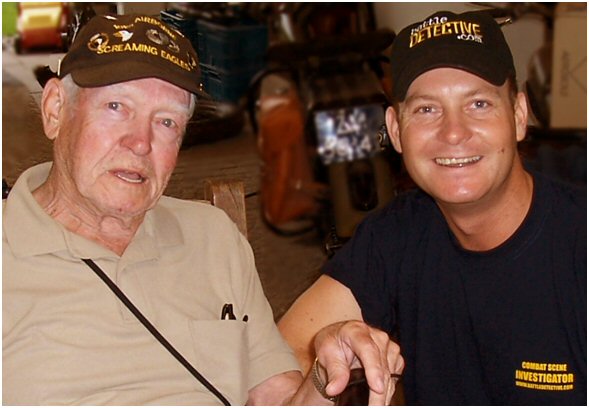
(Tech Sgt. Lud
Labudka of Easy Company, 502nd
Parachute Infantry Regiment and
Battle Detective Tom)
Asked what he could tell about the
pills that where issued just before
the D-Day jump, Lud said:
"I may have been given these
pills but I would have thrown them
away. See, during all the jumps
during paratrooper training we where
never given air sickness pills. I
had my 13th jump on my 21st
Birthday. That was in England prior
to D-Day. I never take pills. I
won't even take painkillers today. I
did drink Aqua Velva though on the
flight to Normandy on D-day. Someone
on my stick handed me a bottle and I
took a swig. It made me sick!"
(For the complete Aqua Velva story,
please read
Para Research Team Don's
report.)
11) After reading this article, Ken
McAuliffe, nephew of the famous
General Anthony C. McAuliffe, sent
this e-mail on the 15th of January
2008:
"Tom,
Here is a contribution to your
Battle Relic #7.
This is a portion of a letter
General McAuliffe wrote to his wife
on September 26, 1944.
Starrett was Lt. Fred Starrett,
his aide. I included more than just
the air sickness pills.
Thought it would be interesting
to you.
Ken McAuliffe"
This is the portion of the letter
Ken referred to:
"Darling:
I guess you know we are somewhere in
Holland and doing O.K., though we
have had and are having some hard
fighting. [...] I brought in the
glider echelon this time, hundreds
of them. It was something I had
wanted to do. The flak was
nerve-wracking. Got holes thru my
jeep and my tug plane had its right
engine shot out 10 miles from the
drop zone. The pilot, Col. Bill
Whitaker, bravely decided to tow me
in anyway, rather than drop me by
myself in enemy territory. I hear
Bill landed safely. It was a
memorable experience, flying the
channel, swinging at the end of a
rope.
I had anti-seasick pills, but
didn't take them. Gave them to
Starrett, who took three at once and
went out of his head. He had to be
knocked out and went to hospital
when we got there. He got out the
next day, face all marked up and
minus all equipment. I lost my
bedding roll with all personal
equipment, but fortunately, I sent
my rubber mattress seaborne. I'm in
tough shape for clothes.
We have had a battle every day
and have won them all. Some were
close shaves. I won one that was
greater than Carentan."
General McAuliffe, acting division
commander of the 101st Airborne
Division, became a legend because of
his remarkable reply to a German
surrender demand during the Battle
of the Bulge in December 1944. A
simple 'nuts' was all the German
negotiators got for an answer.
(click on the images
to enlarge)
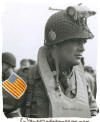
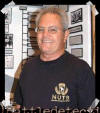
General McAuliffe geared
Ken McAuliffe wearing a T-shirt
up for his glider
ride into
embroidered with the word
Holland
that made his uncle famous
12) A recent publication of
experiences with the "Motion
Sickness Preventive" pills can be
found in the book
"Tonight we die as men, The untold
story if Third Battalion 506
Parachute Regiment from Toccoa to
D-Day", by Ian Gardner and Roger
Day, published in 2009:
'
Dr "Barney" Ryan was manifested on
the no. 2 aircraft with Maj Grant
and recalls:
"I realized I'd left the airsickness
tablets in my tent and rushed back
to get them. I scooped some pills
off the table and when I reached the
aircraft gave them to the men. After
putting them in their mouths they
spluttered, "What the hell are you
trying to do to us – these are salt
pills!" Luckily nobody got airsick.
[...]
Hank DiCarlo suffered terribly from
airsickness. His colleagues Donald
Zahn and Frank Padisak had never
been airsick and generously gave him
their capsules. "I had no idea just
how drowsy those things would make
me feel," recalls Hank. "Because of
my normal laid back demeanor many of
my friends thought I was just being
cool, but in actual fact I was
fighting to keep my eyes open and
stay awake!"
13) On Monday June 10th 2013, US
Army veteran of World War II
James "Pee Wee" Martin, who
served in "G" Company of the 506th
Parachute Infantry Regiment,
explained to us that although the
motion sickness preventive tablets
had been issued to paratroopers in
his unit, he had not taken any. "
I would not let anything interfere
with my mind", Martin said.
His company commander, upon hearing
that air sickness tablets were being
distributed, scooped a handful of
pills from a container and boarded
his C-47 bound for Normandy in the
night of June 5 to 6, 1944.
On board the Captain discovered that
it were salt tablets he had taken
into combat.
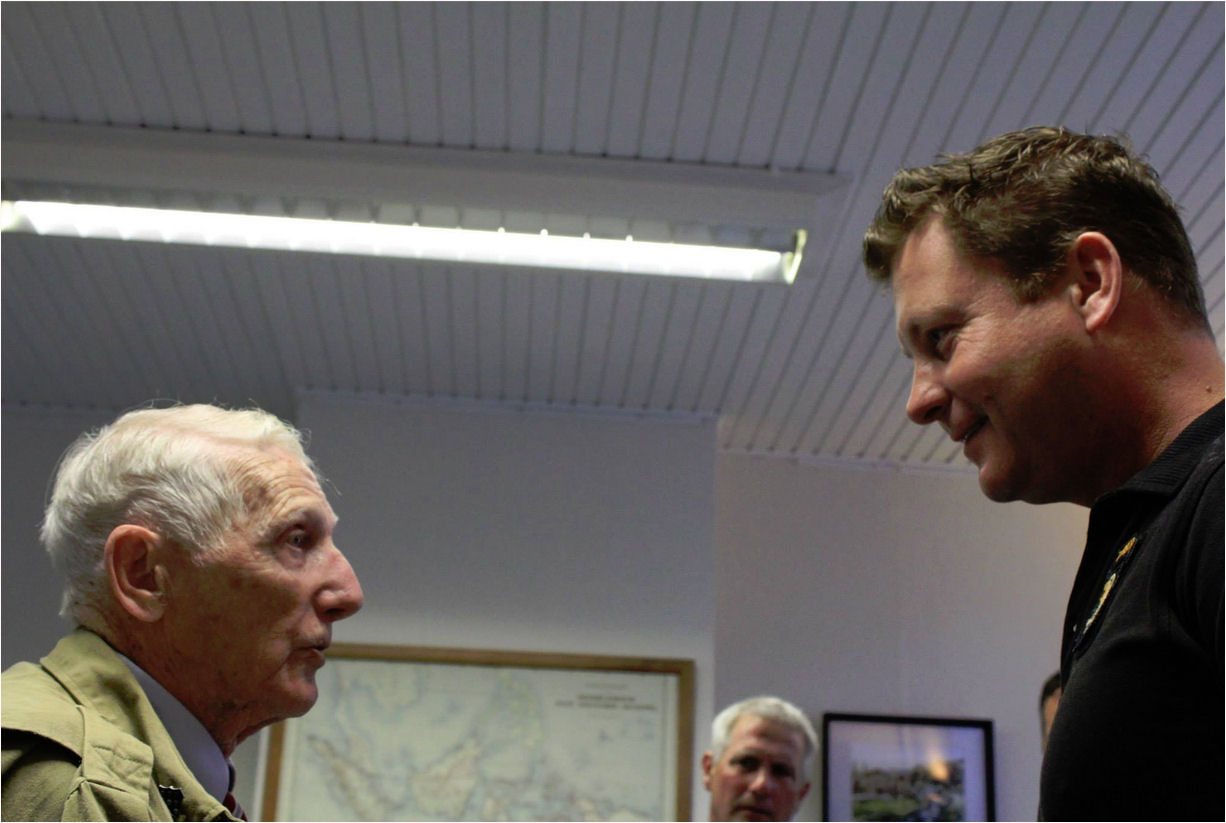
(James
"Pee Wee" Martin of George Company, 506th
Parachute Infantry Regiment and Battle
Detective Tom)
14) The next description of
the effects of the experimental air
sickness pills is rather an update
to account 11).
In their excellent book "orange is
the color of the day authors Peter
Hendrikx and Michel DeTrez wrote:
"After making sure things were
going according to plan, McAuliffe
and his party continue their ride
along the southern edge of the
landing zone. Besides his driver and
two MP bodyguards, McAuliffe’s
aide-de-camp, 1st Lt. Frederic D.
Starrett is also in the jeep.
Starrett’s facial expression
reflects his upset stomach due to an
overdose of anti-seasick pills.
Starrett was feeling so knocked out
that he was sent for the hospital
for the night.
The next day, during the German
counter attack on the Bailey Bridge
at Son, the general’s jeep was
pushed into the Wilhelmina Canal by
a German patrol when Lt. Starrett
left it unattended while assessing
the area."
"Orange is the Color of the Day,
Pictorial history of the 101st
Airborne Division during the
liberation of Holland”
by Peter Hendrikx & Michel DeTrez,
2012 D-Day Paratroopers Historical
Center Publishing, ISBN
978-2-9540297-1-9, Page 60 & 61
Click to enlarge:



(facial expressions
of Brigadier General McAuliffe's
aide-de-camp 1LT Starrett)
15) The description given in
the 2001 publication "Spearheading
D-Day" (ISBN 2 908 182 793 by
Jonathan Gawne, Histoire &
Collections; Third Edition)
accompanied by a photo of the box of
Motion Sickness Preventive pills,
has it all:
On page 104 we read:
"One of the most important items
for the invasion was a small box of
seasick pills. These were Dramanine,
which is still used today for the
same purpose. These pill made some
soldiers very sleepy, which started
the rumor that the Army had issued
sleeping pills to keep the men calm
on the night before the invasion".
Not only claims it that the sole
ingredient of the pills is
Dramamine, it also fuels the rumor
of the pills being a sedative.
Click to enlarge:
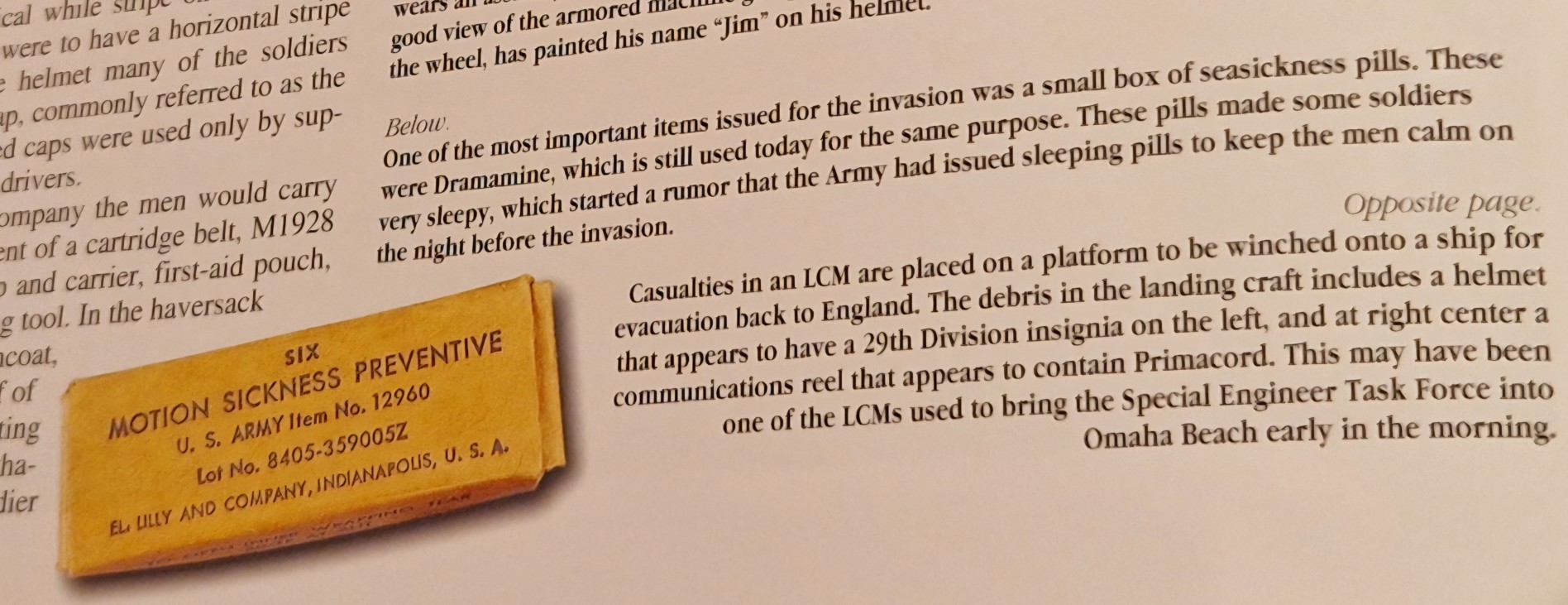
These descriptions show that
there is a lot of controversy
surrounding the actual purpose of
the issuing of these pills and also
about their content. There are
rumors suggesting that these pills where given
under a false pretext and where
meant to reduce fear.
Enough reasons for us to investigate
the story behind these pills.
Investigation: In the 4th and
15th accounts, Koskimaki and Gawne
mention, without revealing their
sources, the brand name Dramamine.
Dramamine is an over-the-counter
anti motion sickness medicine. The
scientific name is Dimenhydrate
(2-benzhydryloxy-N,N-dimethyl-ethanamine;
8-chloro-1,3-dimethyl-7H-purine-2,6-dione)
and the formula is C24H28CIN5O3.

In general, Dramamine is known to
have some of the side effects as
described above.
Battledetective.com owns a box of
World War Two vintage US Army Motion
Sickness Preventive pills. The
tablets are still individually
wrapped in cellophane. We are now
inventorying the possibilities of
analyzing the contents of the
tablets.
|
|
From the following sources, we
conclude that these are the exact
same tablets as used on the night
before D-Day:
1) Michel Detrez's book At the Point
of No Return,
page
165
2) Michel Detrez's book The Way We
Were, Cpl. Forrest Guth,
page 35
Motion Sickness Preventive pills
featured in Modern Packaging
Magazine
The development of the pills and, in
more detail, the packaging, were
described in an article in
the September 1944 issue of Modern Packaging Magazine.
We received this article from a
member of an online forum for U.S.
militaria collectors.
About the history of the tablets,
the article tells us: "After
intensive research and months of
tests, the Army Medical Department
early this year approved a motion
sickness preventive. This remedy is
for distribution to armed forces as
an aid in preventing seasickness and
airsickness. After the war it should
be a valuable aid to sea and air
travelers. The medicine is produced
in tablet form and is now being
manufactured by Eli Lilly and Co."
This is the complete article:
(click on the image
to enlarge)
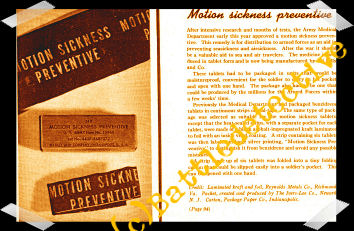
Fatal Poisoning from Motion Sickness
Preventive
We found an article published in the
Journal of the American Medical
Association, dated July 20, 1946,
Vol. 131, pages 971 and 972, titled
"Fatal Poisoning from Motion
Sickness Preventive".
(For the full
article, click here )
In this article the authors, Colonel
F.H. Foucar and Captains B.S. Gordon
and S. Kaye describe a case of three
"general prisoners in the stockade
of a ship returning from England".
One of them was found dead and the
others were sufficiently narcotized
to require hospitalization. They had
taken motion sickness preventive
pills for the intoxicating effect of
them. Judging from the date the
article was published and the fact
that the ship was returning from
England, it is our working
hypothesis, that the incident
involved military personnel and that
it happened during the end of World
War Two in either 1944 or 1945.
The tablets were found to contain
the following chemicals:
1 grain (60 mg.) Sodium Amytal
1/300 grain (0.2 mg.) Scopolamine Hydrobromide
1/400 grain (0,15 mg.) Atropine
Sulfate
An autopsy was performed on the body
of the man who died from the pills.
He was believed to have taken at
least six pills. One of the
surviving men, whose symptoms had
cleared up within 24 hours, stated
that he had taken six tablets.
The authors concluded in their
summary that: "A man died from an
overdose of sodium amytal contained
in a new preparation known, at
present, as "Motion Sickness
Preventive, Army Development Type".
Improper, ungovernable use of this
product may augment the increasing
number of fatalities incident to
barbiturate poisonings."
Forensic toxicological lab analysis
We have found Professor Doctor
Donald R.A. Uges, a reputed forensic
toxicologist from the University of
Groningen willing to analyze one of
our tablets.
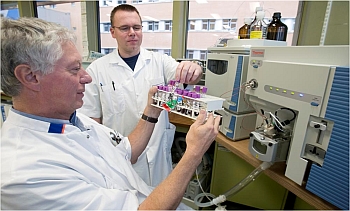
Professor Doctor
Donald Uges
(left)
Photo credit: University of
Groningen, The Netherlands
On October 3rd 2007, we
sent one tablet from our, until so
far, unopened box of Motion Sickness
Preventive to the University Medical
Center Groningen. We included the
article from the Journal of the
American Medical Association and an
unopened tube of over-the-counter
modern-day Dramamine pills
manufactured in the U.S.A. to the
Professor. This was to provide
reference material for a substance
which is designated as such.
(click on the images
to enlarge)
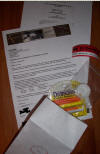

On Thursday October 11th 2007 at
16.30 hours, Professor Uges reported
the results of his test to us by
telephone.This is an account of the telephone
conversation.
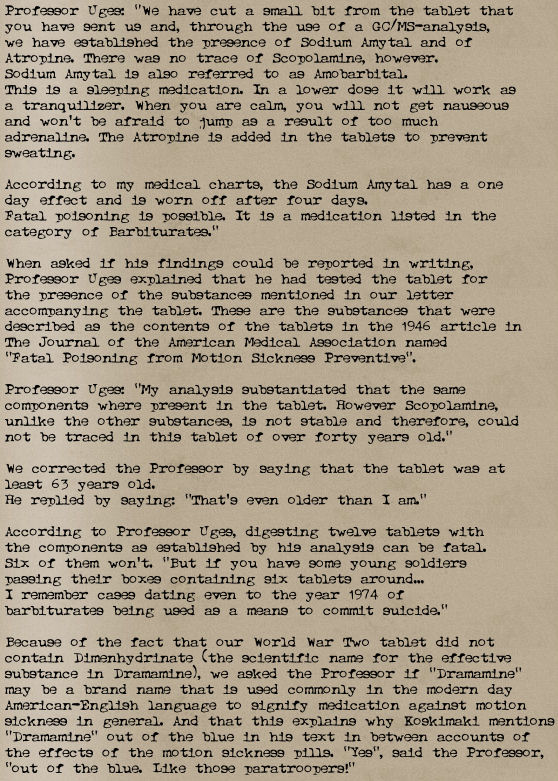
The phone conversation ended at
16.42 hours.
The lab test is listed as a
publication of the Netherlands
Association of
Clinical-Pharmaceutical Analysts in
Hospital Pharmacies on their
website:
(click
to enlarge)
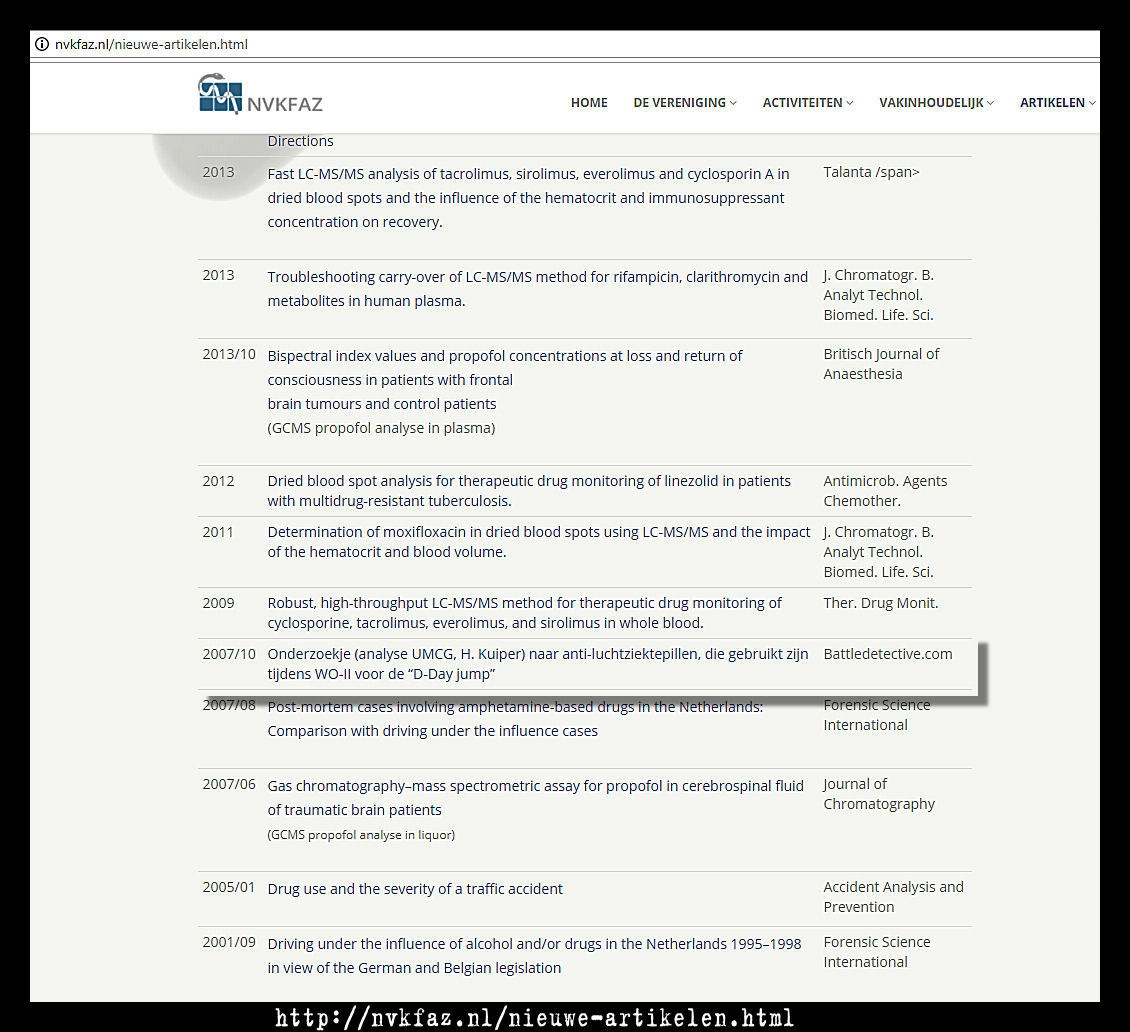
'2007/10
Test (analysis UMCG - University
Medical Center Groningen- H. Kuiper)
of anti-airsickness pills, used
during World War II for the "D-Day
jump" Battledetective.com'
Enquiry to the manufacturer
We wrote to the Eli Lilly and
Company in Indianapolis, Indiana,
the producers of the Motion Sickness
Preventive.
We asked them what they can tell us
about the contents of the tablets
and if the amounts of each component
were altered during World War Two.
We also asked if any research was
done by this company before issuing
the medication to the US Army.
Our first letter was mailed on
October 10th, 2007.
Over the following years our
frequent reminder letters remained
unanswered until
December 14th, 2010 when we received
the following letter:
Eli Lilly and Company
Lilly Corporate Center
Indianapolis, Indiana 46285
U.S.A.
Phone 317 276 2000
December 6, 2010
Mr. Tom
Dear Mr.
We are sorry that it has
taken us so long to respond
to your letter. Your request
has only recently found its
way to the correct location
for response. It has also
taken some time to try and
locate information from 70
years ago. Very little
exits, but we did try our
best to find the answers.
Eli Lilly and Company did
indeed provide several
products to the United
States Armed Forces for use
in World War II. Included
for certain were some very
important life-saving
antibiotics and other
products. Most of these were
provided to the government
after complying with strict
directions from the
government about
ingredients, purity,
packaging, and labeling
matters.
In other words, the
providers of products to the
government often have little
or no ability to deviate
from those requirements.
We do find evidence that
Lilly provided some kind of
motion sickness preventive
product. It appears to be
the same one you describe in
your information. If it is
the same, the box provides
instructions on how to use
the product. We do not know
it those instructions are
the same as you describe or
whether the government may
have changed our directions.
Likewise we do not know what
military personnel would
have told others about how
to properly use the product.
December 6, 2010
Page 2
We find no specific
information about the makeup
of the product itself.
However, the box does
contain language about the
presence of a sedative and
the proper way to use the
product. It also clearly
notes that taking the
product to excess can cause
drowsiness.
Thanks for your interest in
our war time products and
the Lilly effort to support
the Armed Forces during
World War II.
Very truly yours,
Greg Kueterman
Corporate Communications
Eli Lilly and Company
GAK:cmp |
(For the original
letter, click here)
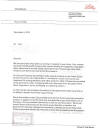
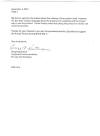
U.S. Military Dramamine
On the same online auction site
where we had purchased the Motion
Sickness Preventive pills, we
noticed the sale of an unopened box
of US Army issue Dramamine. These
are the photographs which
accompanied the auction:
(click on the images
to enlarge)
Judging from the use of the more
modern inner push-through tin foil
strip, we assume that these tablets
are post-World War Two. We also
think that Dramamine was not issued
to the US military until after World
War Two.
Literature on Sodium Amytal,
Scopolamine Hydrobromide and
Atropine Sulfate
Sodium Amytal / Amobarbital
5-ethyl-5-(3-methylbutyl)-1,3-diazinane-2,4,6-trione
C11H18N2O3
In several (online) publications
Sodium Amytal is described as a type
of medicine called a barbiturate
derivative. It causes drowsiness and
is used to induce sleep. Some side
effects of overdose include
confusion (severe); decrease in or
loss of reflexes; drowsiness
(severe); fever; irritability
(continuing); low body temperature;
poor judgment; shortness of breath
or slow or troubled breathing; slow
heartbeat; slurred speech;
staggering; trouble in sleeping;
unusual movements of the eyes;
weakness (severe). Death can result.
In 1994, 50 years after the Battle
of the Bulge, PBS, in co-operation
with Lennon Documentary Group, The
American Experience and WGBH
Educational Foundation released the
documentary "Battle of the Bulge".
Several veterans of the Battle in
the Ardennes in December 1944 and
January 1945 were interviewed; among
them Harry W.O. Kinnard, battalion
commander in the 501st Parachute
Infantry Regiment.
These are fragments of the
transcripts of some of the veteran
interviews in that documentary:
Ben Kimmelman, Captain, 28th
Infantry Division:
"People who were not necessarily
severely wounded but who were no
longer in charge of themselves, they
would put them in a detachment or an
installation to put them through a
kind of a very quick and dirty
process in which they were given
sodium amytal or one of these
other-- it's a sort of a truth
serum-thing, but it was in the form
of tablets. And this would give them
a very deep, deep sleep, sort of
almost a trance-like sleep for 24,
sometimes or 48 hours.
During this time, the enlisted men
and myself would sometimes go by. We
had to supervise it, because there'd
be screaming and they would be deep,
deep asleep and there'd be terrible
expressions of their fear and their
fright."
[...]
"The assumptions were that this
would have some kind of cathartic
effect, the sodium amytal, which the
men called '"blue 88's." You know,
the most effective artillery piece
of the Germans was the 88 and this
was ''blue 88's,'' because the
sodium amytal was a blue tablet.
And then they would-- they would
come out of this in, depending on
the dosage, 24, 48, 72 hours, and
they'd be walking around, completely
numb. Sometimes they would be
slipping and falling. That took a
few more hours. And then they would
be given a shower, new clothes and a
pep talk and the attempt was made to
send them back. I say the attempt
because it didn't always succeed.
They weren't suitable to be
returned.
And in a sense, the thing that
repelled me so badly was that you
were talking to men who weren't
quite yet still in charge of
themselves and you were sort of
shepherding them back to the front.
And one time, the chief of staff
asked me to go out and talk to them.
He said, ''You're good at that, you
go out and talk.'' I said,
''Colonel, I really don't want to do
it.'' He said, ''I know, Ben.'' He
said, ''Do it, anyhow.'' And I went
out and I tried haphazardly to try
to get them-- to persuade them to
get in the trucks and go back.
They'd finished with their 72 hours,
they'd gotten their clothes, and
they just looked at me. And half of
them looked as if they couldn't
focus.
And finally one of them said,
''Don't you guys understand? If you
can still walk and see, they'll keep
shipping you back.'' So I didn't do
that again, and I told my commanding
officer I wouldn't."
Scopolamine Hydrobromide
(-)-(S)-3-Hydroxy-2-phenyl-propionic
acid
(1R,2R,4S,7S,9S)-9-methyl-3-oxa-9-aza-tricyclo[3.3.1.02,4]non-7-yl
ester
C17H21NO4
Scopolamine, also known as hyoscine,
is a drug obtained from plants of
the family Solanaceae (nightshades),
such as henbane or jimson weed.
Scopolamine is named after the plant
genus Scopolia. The name "hyoscine"
is from the scientific name for
henbane, Hyoscyamus niger. The
scientific formula is C17H21NO4 .
The drug can be highly toxic and
should be used in minute doses. As
an example, in the treatment of
motion sickness, the dose, gradually
released from a transdermal patch,
is only 0.33 milligram of
scopolamine per day.
Note that each one of the Motion
Sickness Preventive tablets
contained 0.2 milligram. If the
instructions on the outside box is
followed to the letter ("Take one 30
minutes before and one at the time
of embarking. Then take not more
often than every four hours.")
within 24 hours at least 6 tablets
can be digested. This means a dose
of 1.2 milligram; more than three
and a half times the dose which is
advised today.
An overdose can cause delirium,
delusions, paralysis, stupor and
death.
Scopolamine is used criminally as a
date rape drug and as an aid to
robbery, the most common act being
the clandestine drugging of a
victim's drink. It is preferred
because it induces retrograde
amnesia, or an inability to recall
events prior to its administration
or during the time of intoxication.
Atropine Sulfate
(8-methyl-8-azabicyclo[3.2.1]oct-3-yl)
3-hydroxy-2-phenylpropanoate
(C17H23NO3)2 H2SO4 H2O
Atropine is extracted from the
deadly nightshade (Atropa
belladonna) and other plants of the
family Solanaceae. It serves as a
drug with a wide variety of effects.
Being potentially deadly, it derives
its name from Atropos, one of the
three Fates who, according to Greek
mythology, chose how a person was to
die.
The most common atropine compound
used in medicine is atropine sulfate
Generally, atropine lowers the "rest
and digest" activity of all muscles
and glands regulated by the
parasympathetic nervous system. This
occurs because atropine is a
competitive antagonist of the
muscarinic acetylcholine receptors.
Therefore, it may cause swallowing
difficulties and reduced secretions.
Compare this with Lt. Jim Allen's
account on page 72 of George
Koskimaki's D-Day with the Screaming
Eagles: "[...] when I tried to
call him, my mouth was so dry and my
tongue was so thick that not a sound
came out. I couldn't talk!'"
In overdoses, atropine is poisonous.
Atropine is sometimes added to other
potentially addictive drugs; abuse
of those drugs is then prevented by
the unpleasant effects of atropine
overdose.
1944 Article by George Holt, US
Army Medical Department
Also through the same US Militaria
Forum member as
the article from Modern Packaging
Magazine, Mr. Dustin Clingenpeel, we received an article
written by Lieutenant-Colonel George
W. Holt of the U.S. Army Medical
Corps.
The article describes the military
need of motion sickness preventive
medication.
Holt gives an example: "The
occurrence of vomiting in one
individual in a glider may result in
nausea and vomiting in other troops
in the same glider."
In light of our research, these
phrases are of interest: "A drug has
not be found which is a specific for
motion sickness. Those which have
been used are thought to be about 50
per cent effective. The use of
depressive drugs, if over done,
would result in combat inefficiency.
It therefore is necessary that
careful experimental investigation
determine that the dosage of the
drug used does not interfere with
combat inefficiency.[...]The
mechanism of action of the
hyoscine-scopolamine group has not
as yet been exhaustively
investigated. It is known, however,
that this group acts as a
depressant."
This is the complete article:
(Click on the images
for the complete article)
1945 Article By Lieut. Joseph L.
Lilienthal, Jr., MC, USNR, Naval
School of Aviation Medicine
Dustin Clingenpeel also forwarded an
article to us, published in 1945,
titled "The Effect of Hyoscine on
Airsickness".
In the closing discussion of the
article a Lieut. Col. Harwell
remarked: [...]"We have no way of
knowing, as the Doctor brought out,
how long the effect of one dose of
scopolamine would last, because we
know scopolamine is
eliminated in two ways. Thus we
prepared our doses to give them
every two hours. The effect of
one dose would not last more than
two hours.
The second fact is that in very
hot weather you get a severe
reaction. In other words, if you
give a little larger dose you may
run the temperature up to a hundred
and three and four, where the
thermometer registers ninety five or
one hundred degrees, you may be
amazed to find that the baby is born
with a temperature of one hundred
and three.
So, I think in desert warfare or
hot climates it might be well to
check on the length of time it will
prevent air sickness.
In obstetrical work we do a skin
test where we inject 1/100
thousandths under the skin to
determine how much of a reaction you
will get.
For instance, in many of the
patients we find that there will be
a reaction, and there will be an
extensive area of redness around the
site of the intradermal injection,
and those are the patients with whom
you will have to go a little slower
in giving the drug.[...]"
These remarks lead to the conclusion
that the effects of the 'ingredient'
Hyoscine/Scopolamine may differ from
soldier to soldier. Also the
temperature of the soldier's body
and of his environment may influence
the effect of the drug. Most of the
airborne men who jumped on D-Day had
had their paratrooper training in
sizzling hot Southern states, such
as Georgia and North Carolina. They
were used to parachuting and
maneuvering in a hot climate. On the
other hand, they had spent the
entire year before D-Day in damp
England. Also they had never taken
the motion sickness preventive
tablets before.
These circumstances may have
contributed to the occurrence of the
drug's side effects.
This is the complete article:
(Click on the images
for the complete article)
After the war, the U.S. Military was
more careful to mix all three
substances into one tablet. The
choice was made to use the more
dependable ingredient Scopolamine
Hydrobromide. Also a caution in
stronger words was printed on the
package as this postwar box of "Sea
Sickness Preventative" shows:
(click on the images
to enlarge)
Conclusion
We have established that the Motion
Sickness Preventive tablets issued
to the US Army paratroopers who
jumped in the night before D-day,
did not contain Dramamine.
Instead, they contained a
barbiturate which, in quantities as
high as the contents of two of the
standard boxes issued to these
troops (a total of 12 tablets), can
be deadly.
It also contained substances that
can easily be taken in an overdose
causing deliriums or impairing the
speech.
When digested in the amount of the
content of one box (six tablets) it
will at least have effects that are
undesirable to men in combat, who
have to be alert when dropped behind
enemy lines during the night.
Also, the instructed dose on the
tablets' package is not generally
suitable to all users, as various
circumstances can influence the
effects of the tablets.
In worst scenario's, the tablets
will cause combat ineffectiveness.
It is highly questionable if the
U.S. Army has conducted sufficient
research prior to giving the
manufacturing contract to the
pharmaceutical company and before
issuing these tablets to
paratroopers.
This makes the following
recommendation in the 326th Airborne
Medical Company's Annual Report for
the year 1944 remarkable, to say the
least:

(For the full report, click here)
|


